Testing the tourism - Led growth hypothesis for Vietnam
The study empirically investigate the relationship between tourism receipts, exchange rate and economic growth in the period 1990-2017 and define whether the tourism -led growth (TLG) hypothesis for Vietnam. The study implements Vector Error correction Model, Granger causality tests, variance decomposition with data in the periods 1990 -2017. The results point out that Gross Domestic Product (GDP), Tourism Receipts (TR) and Real exchange rate (EXR) are cointegrated, implying a long-run relationship between three variables. The value of ECM (-1) = 0.6388, this shows that speed of adjustment toward long run equilibrium is about 1.5 year. There is long run causality running between TR, GDP and EXR. In the short run, there is causality relation between GDP and TR, between EXR and TR. Tourism industry has contributed in solving employments, brought foreign currencies and the results give the evidences that tourist -led growth hypothesis (TLG) is accepted in the case of Vietnam in the period 1990-2017. The study also proposed some recommendations to develop Vietnam economy
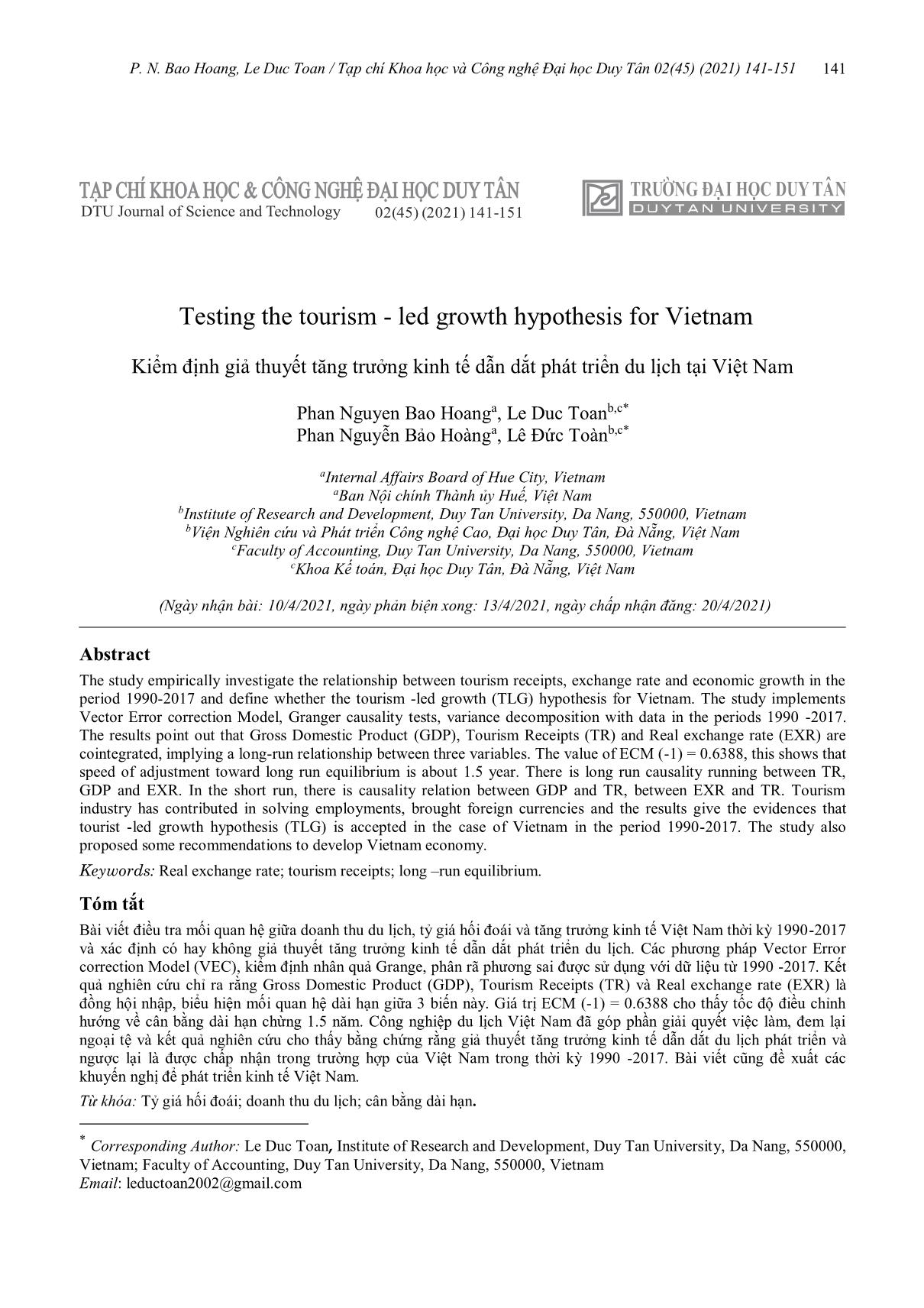
Trang 1
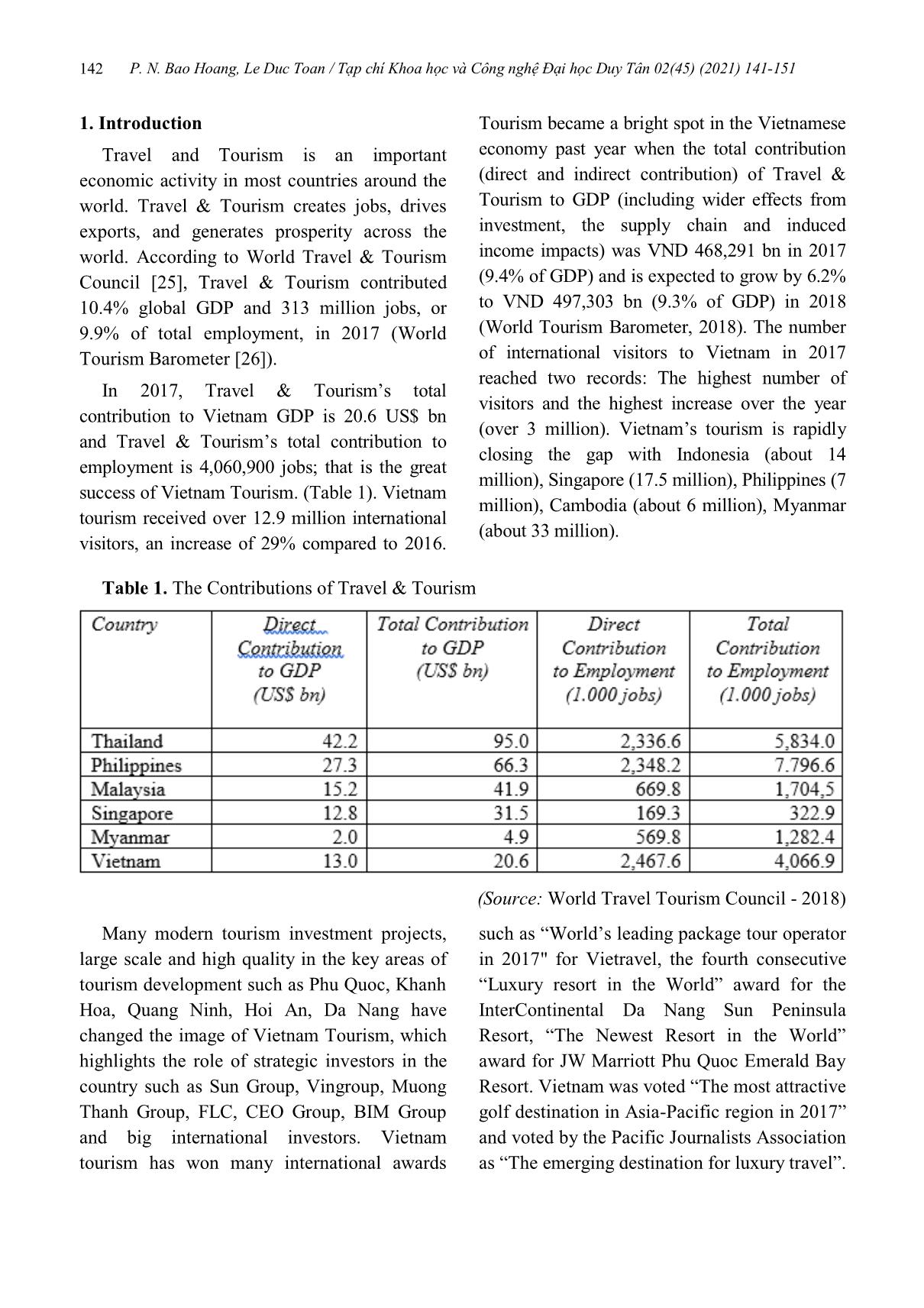
Trang 2
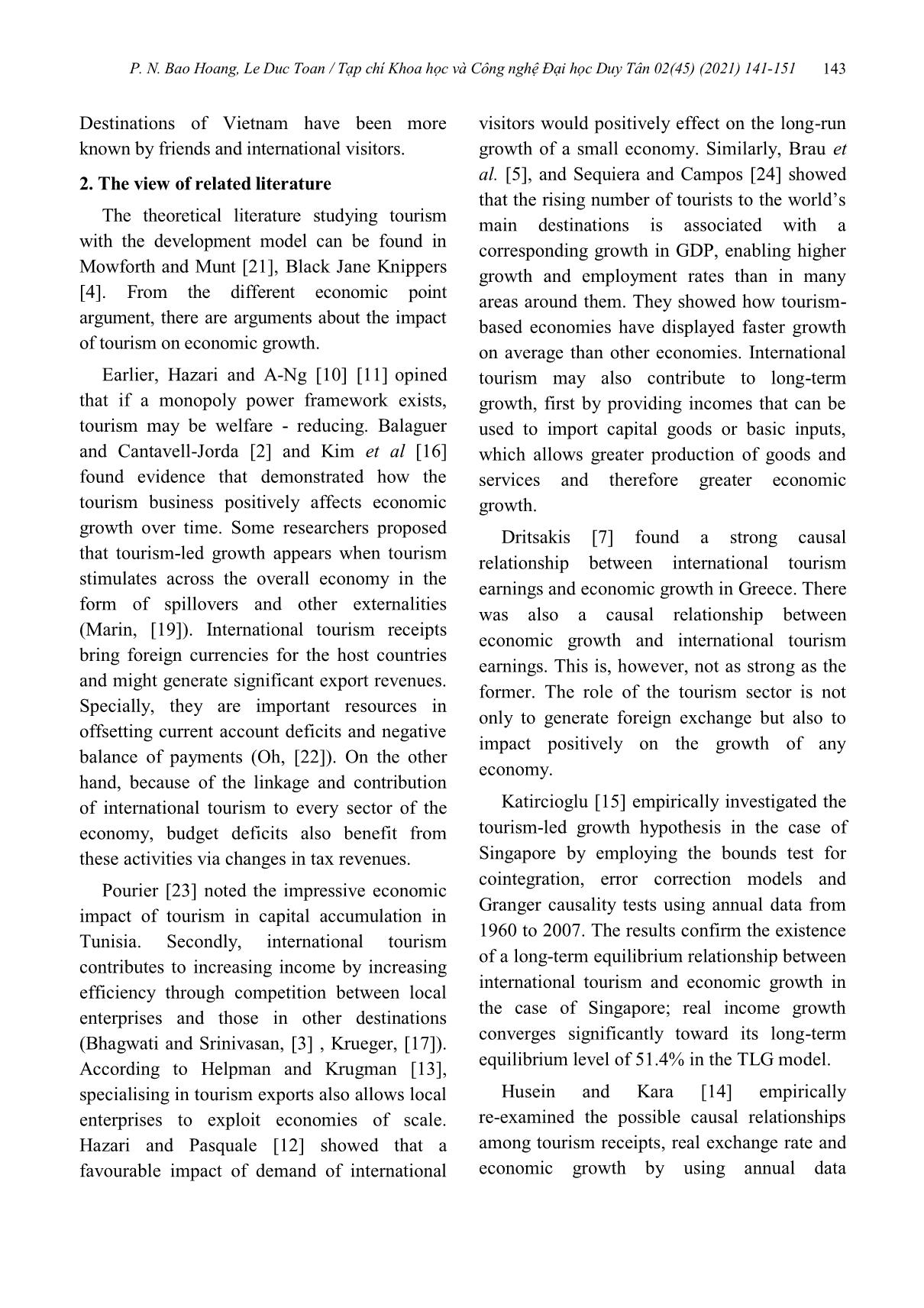
Trang 3
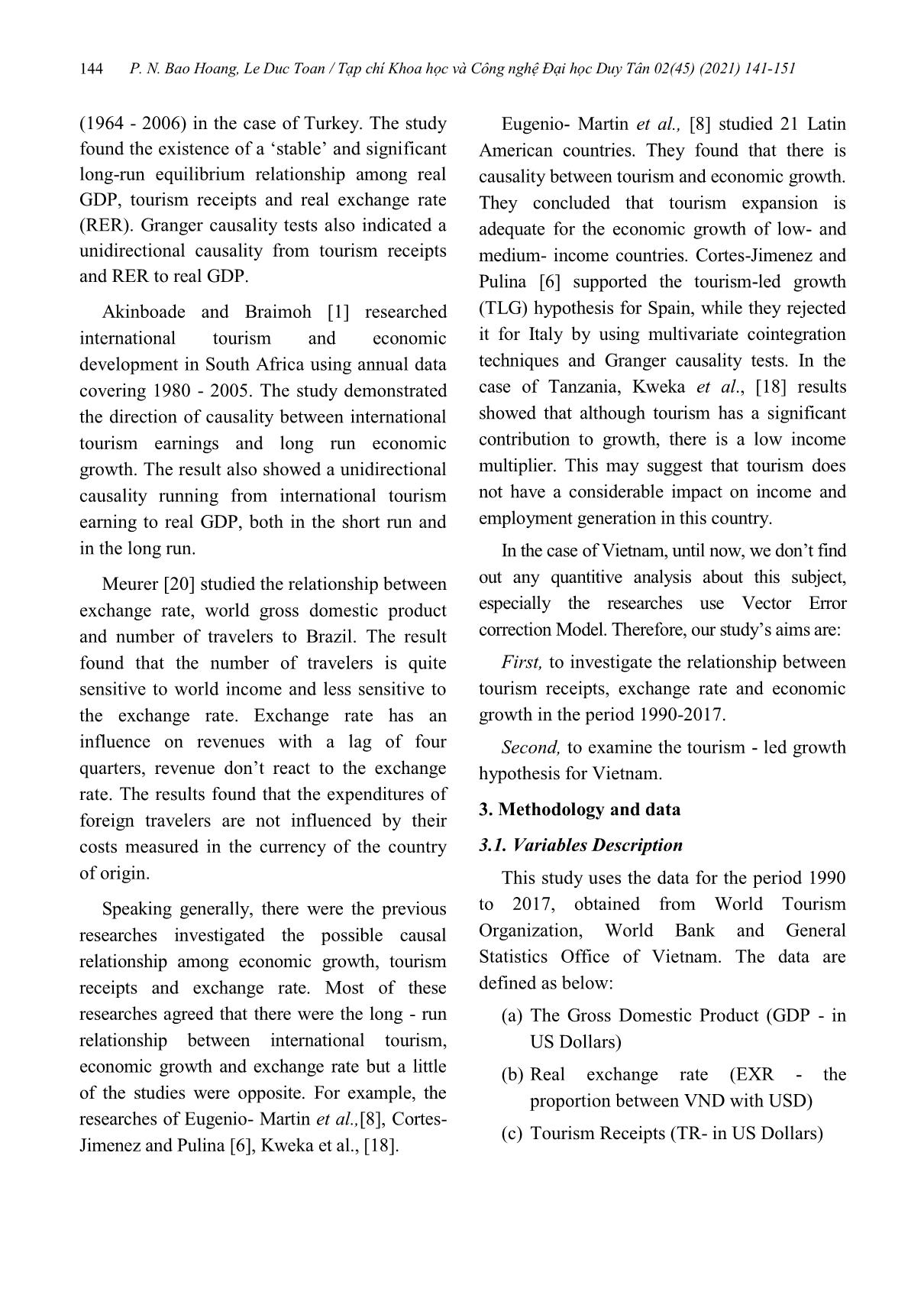
Trang 4
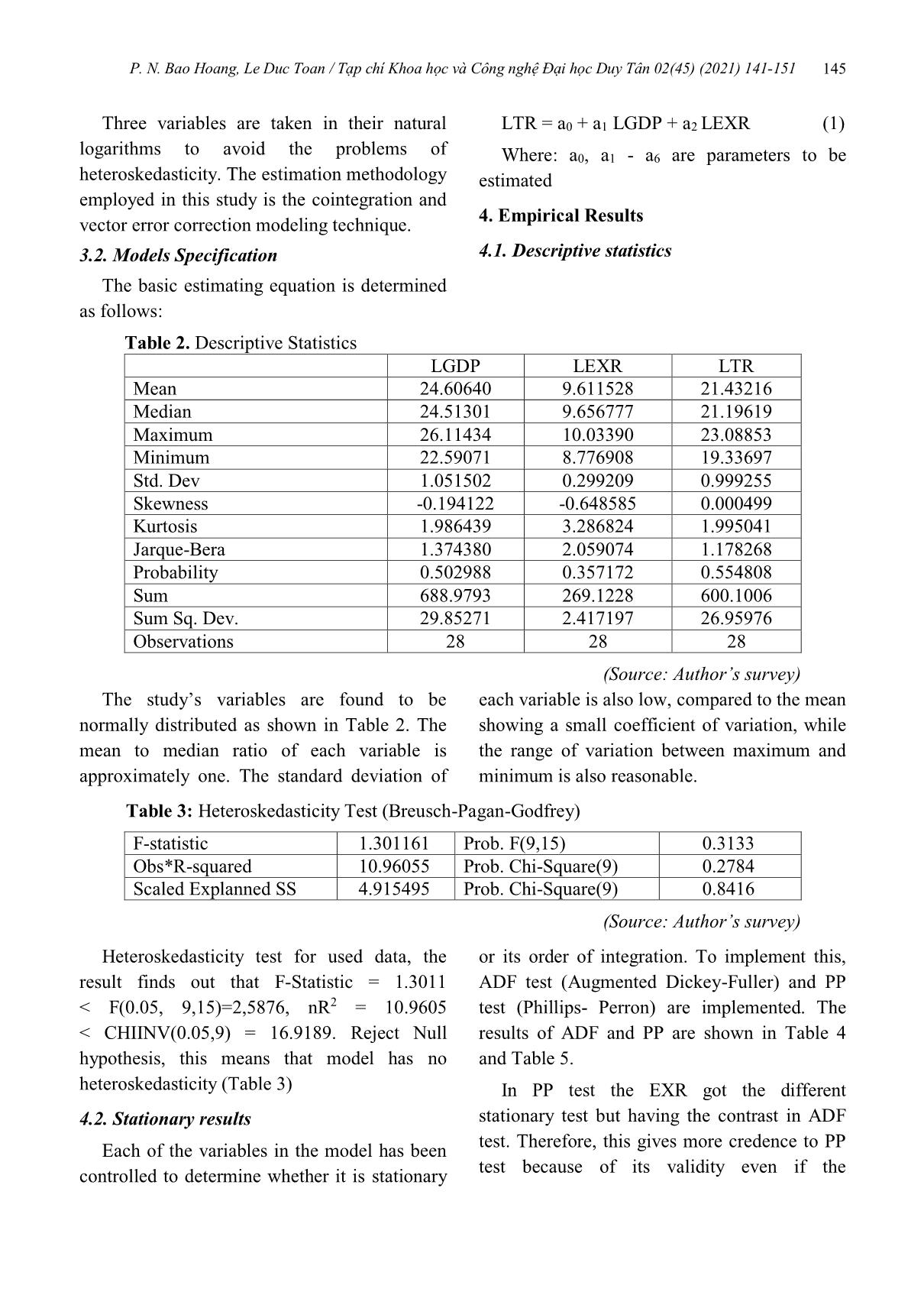
Trang 5
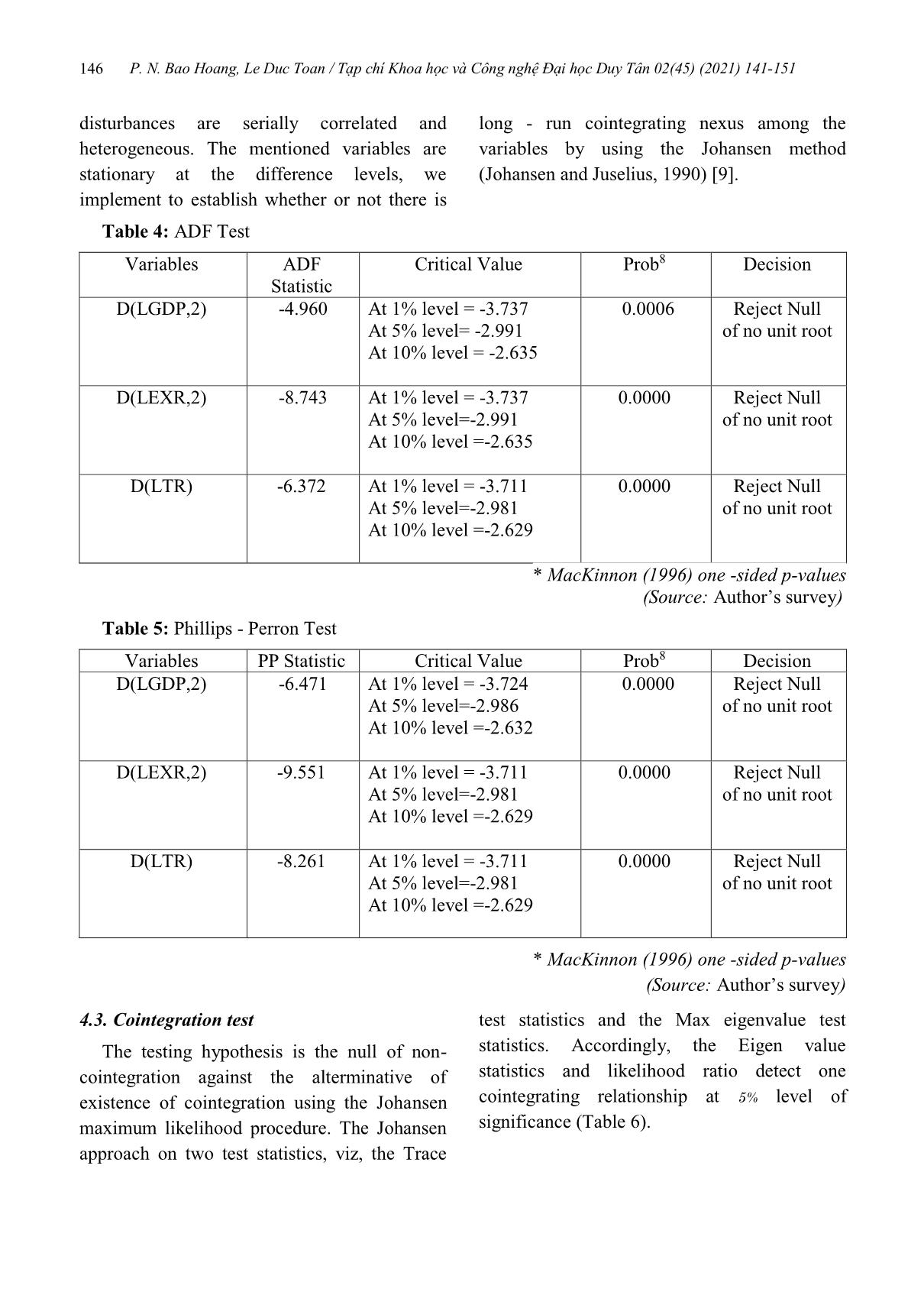
Trang 6
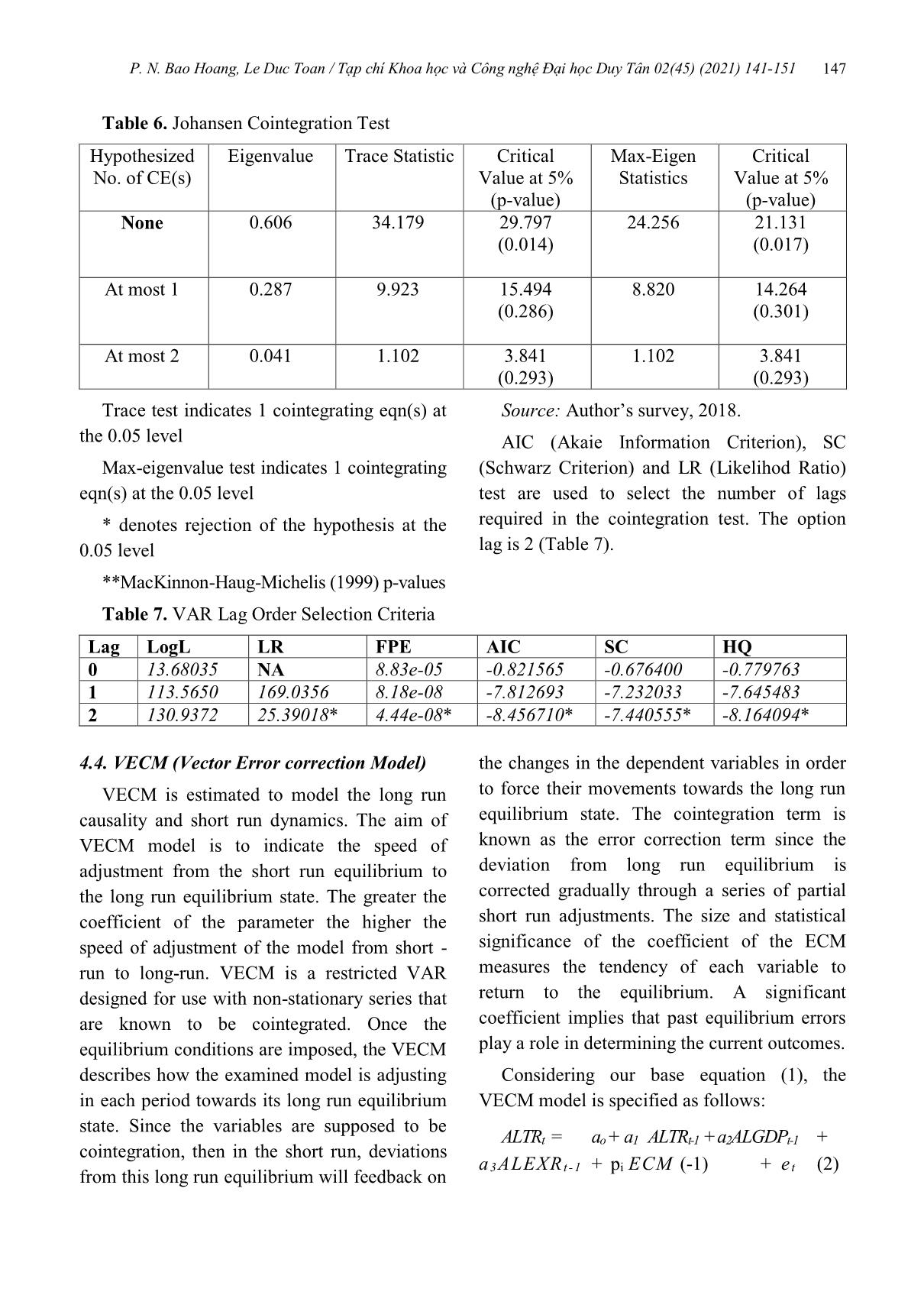
Trang 7

Trang 8
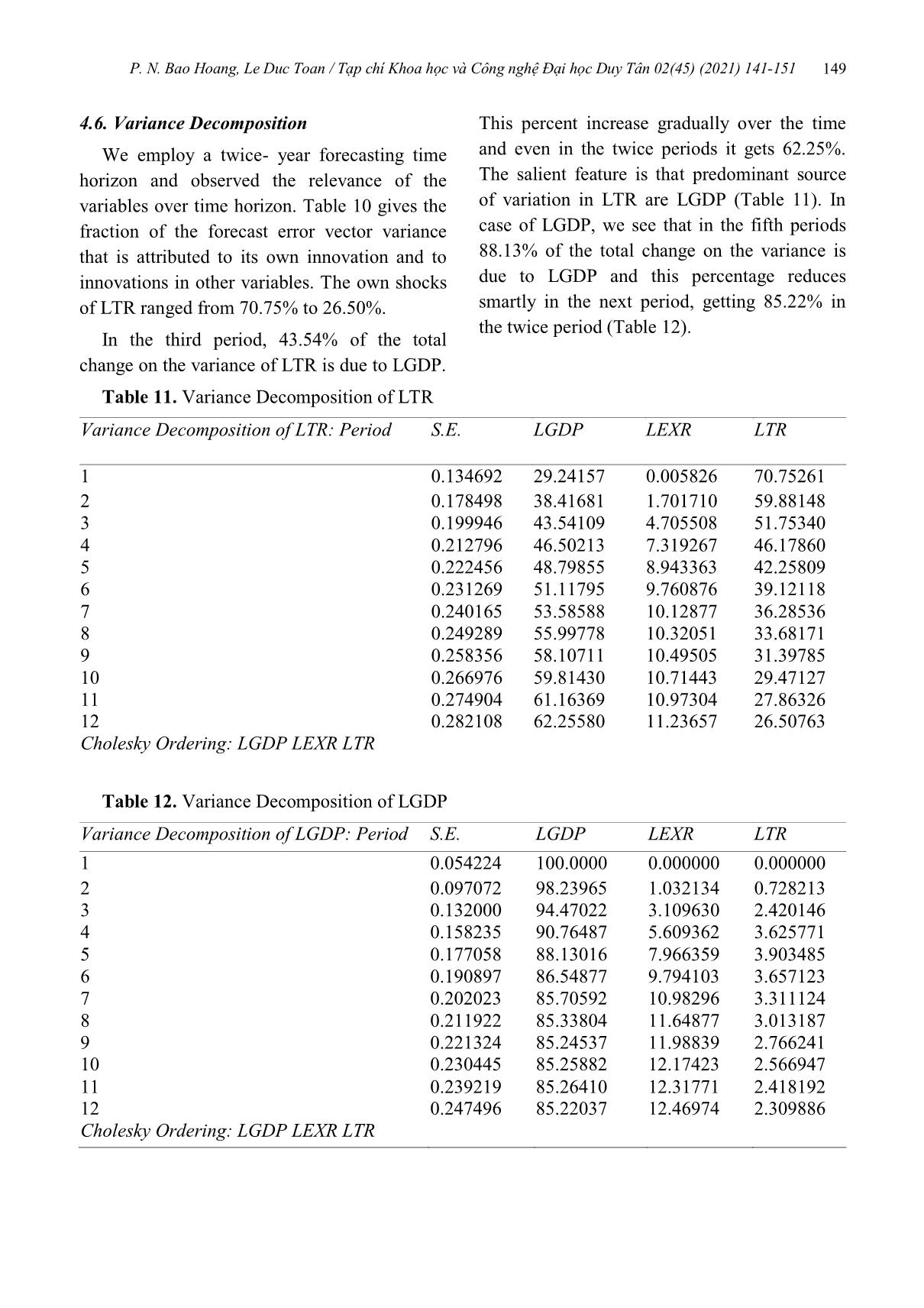
Trang 9
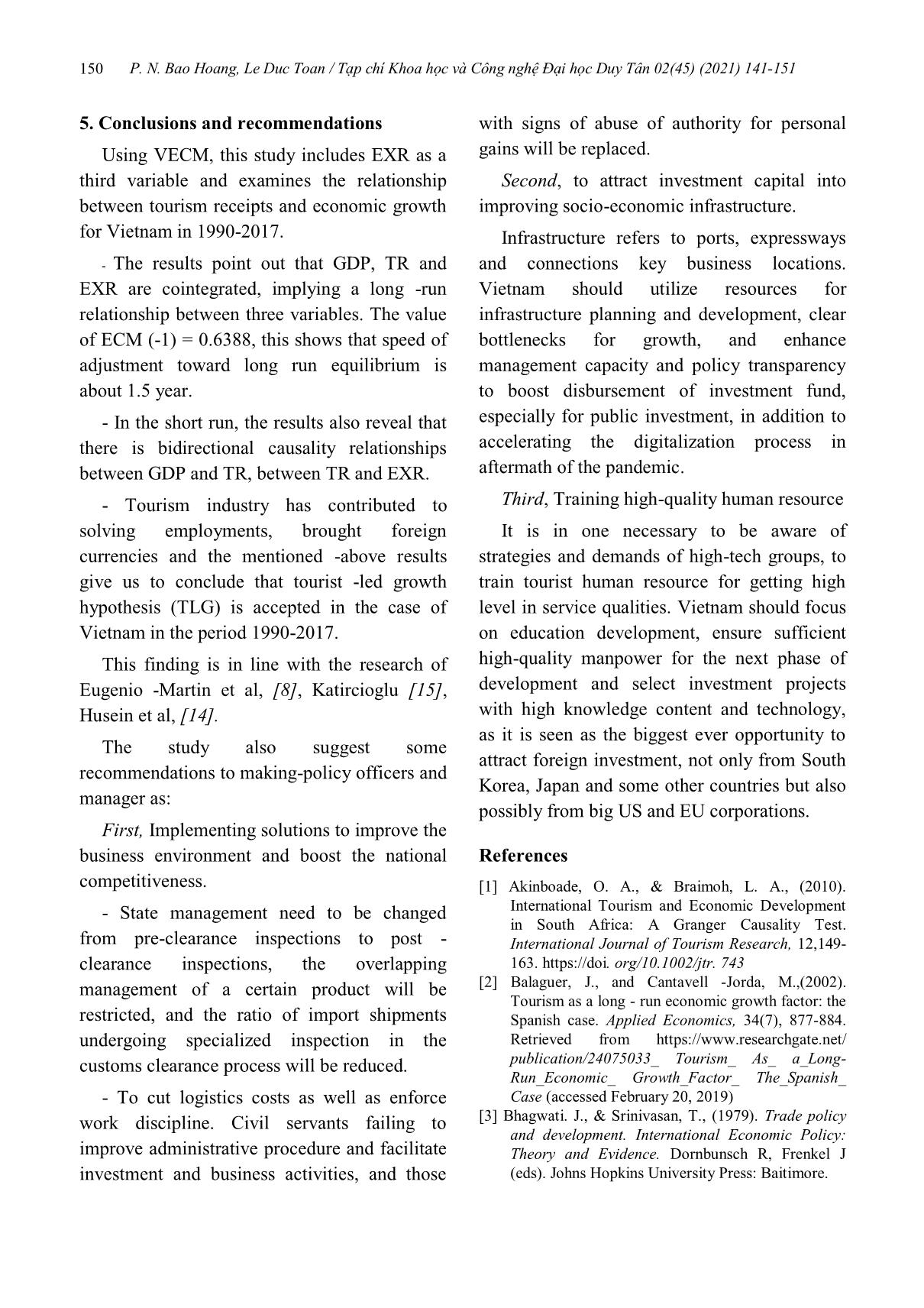
Trang 10
Tải về để xem bản đầy đủ
Tóm tắt nội dung tài liệu: Testing the tourism - Led growth hypothesis for Vietnam
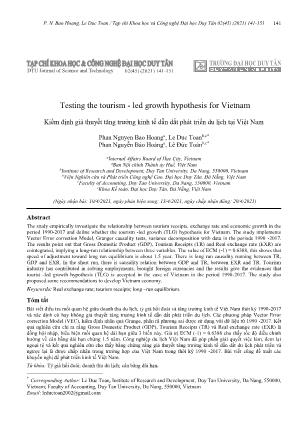
05 level * denotes rejection of the hypothesis at the 0.05 level **MacKinnon-Haug-Michelis (1999) p-values Source: Author’s survey, 2018. AIC (Akaie Information Criterion), SC (Schwarz Criterion) and LR (Likelihod Ratio) test are used to select the number of lags required in the cointegration test. The option lag is 2 (Table 7). Table 7. VAR Lag Order Selection Criteria Lag LogL LR FPE AIC SC HQ 0 13.68035 NA 8.83e-05 -0.821565 -0.676400 -0.779763 1 113.5650 169.0356 8.18e-08 -7.812693 -7.232033 -7.645483 2 130.9372 25.39018* 4.44e-08* -8.456710* -7.440555* -8.164094* 4.4. VECM (Vector Error correction Model) VECM is estimated to model the long run causality and short run dynamics. The aim of VECM model is to indicate the speed of adjustment from the short run equilibrium to the long run equilibrium state. The greater the coefficient of the parameter the higher the speed of adjustment of the model from short - run to long-run. VECM is a restricted VAR designed for use with non-stationary series that are known to be cointegrated. Once the equilibrium conditions are imposed, the VECM describes how the examined model is adjusting in each period towards its long run equilibrium state. Since the variables are supposed to be cointegration, then in the short run, deviations from this long run equilibrium will feedback on the changes in the dependent variables in order to force their movements towards the long run equilibrium state. The cointegration term is known as the error correction term since the deviation from long run equilibrium is corrected gradually through a series of partial short run adjustments. The size and statistical significance of the coefficient of the ECM measures the tendency of each variable to return to the equilibrium. A significant coefficient implies that past equilibrium errors play a role in determining the current outcomes. Considering our base equation (1), the VECM model is specified as follows: ALTRt = ao + a1 ALTRt-1 + a2ALGDPt-1 + a3ALEXR t -1 + pi ECM (-1) + e t (2) P. N. Bao Hoang, Le Duc Toan / Tạp chí Khoa học và Công nghệ Đại học Duy Tân 02(45) (2021) 141-151 148 Where A is the first difference operator, ECM (-l) is the error correction term, et is the error term, pi captures the long run impact. The error correction coefficient pi is very important in this error correction estimation as the greater coefficient indicates higher speed of adjustment of the model from the short run to the long run. Table 8. Model D(LTR) Variable Coefficient Std.Error t-statistics Prob ECM(-1) 0.638838 0.26622 2.39966 0.0281 D(LGDP(-1)) -0.541160 0.58650 -0.92269 0.3691 D(LGDP(-2)) 0.994028 0.52344 1.89903 0.0747 D(LEXR(-1)) -0.479523 0.89535 -0.53557 0.5992 D(LEXR(-2)) 1.105575 0.48182 2.29459 0.0348 D(LTR(-1)) 0.431016 0.25358 1.69975 0.1074 D(LTR(-2)) -0.079137 0.21781 -0.36334 0.7208 C -0.025138 0.08789 -0.28601 0.7783 R -Squared = 0.380413, Adjusted R-squared =0.1252. (Source: Author’s survey, 2018) ECM (-1) = 0.6388 and p-value = 0.0281. These coefficients are statistically significant, there is the long - run relationship between LTR and other variables (LGDP, LEXR). Table 9 shows LM test, this test is used to inspect whether there is serial correlation or not between three variables. F=1.13 < F(0.05, 3-1, 15) = 3.682. The results have suggested the acceptance of null hypothesis. There is no serial correlation, it means that the disturbance term relating to any variable has not been influenced by the disturbance term relating to another variable. Table 9. Breusch-Godfrey Serial Correlation LM Test F-statistic 1.132491 Prob. F(2,15) 0.3483 Obs*R-squared 3.279733 Prob. Chi-Square(2) 0.1940 The results in Table 10 show the Pairwise Granger causality test among the variables analyzed. In the short -run, the results indicate that: - There is bidirectional causality relationships between GDP and TR, between TR and EXR - There is no causality relation between EXR and GDP 4.5. Causality test Table 10. Pairwise Granger Causality Tests Null Hypothesis Obs F-Statistic Prob. Decision LEXR does not Granger Cause LGDP LGDP does not Granger Cause LEXR 26 3.70978 13.2584 0.0417 0.0002 Accept Accept LTR does not Granger Cause LGDP LGDP does not Granger Cause LTR 26 2.38968 1.29338 0.1161 0.2953 Reject Reject LTR does not Granger Cause LEXR LEXR does not Granger Cause LTR 26 1.15586 1.74240 0.3340 0.1995 Reject Reject P. N. Bao Hoang, Le Duc Toan / Tạp chí Khoa học và Công nghệ Đại học Duy Tân 02(45) (2021) 141-151 149 4.6. Variance Decomposition We employ a twice- year forecasting time horizon and observed the relevance of the variables over time horizon. Table 10 gives the fraction of the forecast error vector variance that is attributed to its own innovation and to innovations in other variables. The own shocks of LTR ranged from 70.75% to 26.50%. In the third period, 43.54% of the total change on the variance of LTR is due to LGDP. This percent increase gradually over the time and even in the twice periods it gets 62.25%. The salient feature is that predominant source of variation in LTR are LGDP (Table 11). In case of LGDP, we see that in the fifth periods 88.13% of the total change on the variance is due to LGDP and this percentage reduces smartly in the next period, getting 85.22% in the twice period (Table 12). Table 11. Variance Decomposition of LTR Variance Decomposition of LTR: Period S.E. LGDP LEXR LTR 1 0.134692 29.24157 0.005826 70.75261 2 0.178498 38.41681 1.701710 59.88148 3 0.199946 43.54109 4.705508 51.75340 4 0.212796 46.50213 7.319267 46.17860 5 0.222456 48.79855 8.943363 42.25809 6 0.231269 51.11795 9.760876 39.12118 7 0.240165 53.58588 10.12877 36.28536 8 0.249289 55.99778 10.32051 33.68171 9 0.258356 58.10711 10.49505 31.39785 10 0.266976 59.81430 10.71443 29.47127 11 0.274904 61.16369 10.97304 27.86326 12 0.282108 62.25580 11.23657 26.50763 Cholesky Ordering: LGDP LEXR LTR Table 12. Variance Decomposition of LGDP Variance Decomposition of LGDP: Period S.E. LGDP LEXR LTR 1 0.054224 100.0000 0.000000 0.000000 2 0.097072 98.23965 1.032134 0.728213 3 0.132000 94.47022 3.109630 2.420146 4 0.158235 90.76487 5.609362 3.625771 5 0.177058 88.13016 7.966359 3.903485 6 0.190897 86.54877 9.794103 3.657123 7 0.202023 85.70592 10.98296 3.311124 8 0.211922 85.33804 11.64877 3.013187 9 0.221324 85.24537 11.98839 2.766241 10 0.230445 85.25882 12.17423 2.566947 11 0.239219 85.26410 12.31771 2.418192 12 0.247496 85.22037 12.46974 2.309886 Cholesky Ordering: LGDP LEXR LTR P. N. Bao Hoang, Le Duc Toan / Tạp chí Khoa học và Công nghệ Đại học Duy Tân 02(45) (2021) 141-151 150 5. Conclusions and recommendations Using VECM, this study includes EXR as a third variable and examines the relationship between tourism receipts and economic growth for Vietnam in 1990-2017. - The results point out that GDP, TR and EXR are cointegrated, implying a long -run relationship between three variables. The value of ECM (-1) = 0.6388, this shows that speed of adjustment toward long run equilibrium is about 1.5 year. - In the short run, the results also reveal that there is bidirectional causality relationships between GDP and TR, between TR and EXR. - Tourism industry has contributed to solving employments, brought foreign currencies and the mentioned -above results give us to conclude that tourist -led growth hypothesis (TLG) is accepted in the case of Vietnam in the period 1990-2017. This finding is in line with the research of Eugenio -Martin et al, [8], Katircioglu [15], Husein et al, [14]. The study also suggest some recommendations to making-policy officers and manager as: First, Implementing solutions to improve the business environment and boost the national competitiveness. - State management need to be changed from pre-clearance inspections to post - clearance inspections, the overlapping management of a certain product will be restricted, and the ratio of import shipments undergoing specialized inspection in the customs clearance process will be reduced. - To cut logistics costs as well as enforce work discipline. Civil servants failing to improve administrative procedure and facilitate investment and business activities, and those with signs of abuse of authority for personal gains will be replaced. Second, to attract investment capital into improving socio-economic infrastructure. Infrastructure refers to ports, expressways and connections key business locations. Vietnam should utilize resources for infrastructure planning and development, clear bottlenecks for growth, and enhance management capacity and policy transparency to boost disbursement of investment fund, especially for public investment, in addition to accelerating the digitalization process in aftermath of the pandemic. Third, Training high-quality human resource It is in one necessary to be aware of strategies and demands of high-tech groups, to train tourist human resource for getting high level in service qualities. Vietnam should focus on education development, ensure sufficient high-quality manpower for the next phase of development and select investment projects with high knowledge content and technology, as it is seen as the biggest ever opportunity to attract foreign investment, not only from South Korea, Japan and some other countries but also possibly from big US and EU corporations. References [1] Akinboade, O. A., & Braimoh, L. A., (2010). International Tourism and Economic Development in South Africa: A Granger Causality Test. International Journal of Tourism Research, 12,149- 163. https://doi. org/10.1002/jtr. 743 [2] Balaguer, J., and Cantavell -Jorda, M.,(2002). Tourism as a long - run economic growth factor: the Spanish case. Applied Economics, 34(7), 877-884. Retrieved from https://www.researchgate.net/ publication/24075033_ Tourism_ As_ a_Long- Run_Economic_ Growth_Factor_ The_Spanish_ Case (accessed February 20, 2019) [3] Bhagwati. J., & Srinivasan, T., (1979). Trade policy and development. International Economic Policy: Theory and Evidence. Dornbunsch R, Frenkel J (eds). Johns Hopkins University Press: Baitimore. P. N. Bao Hoang, Le Duc Toan / Tạp chí Khoa học và Công nghệ Đại học Duy Tân 02(45) (2021) 141-151 151 [4] Black Jane Knippers (1991). Development in Theory and Practice. Westview Press Publisher. [5] Brau, R. and Lanza, A. & Pigliaru, F., (2003). How Fast are the Tourism Countries Growing? The Cross-Country Evidence. FEEM Working Paper No. 85.2003. Retrieved from https:// ssrn. com/abstract=453340 or org/10.2139/ssrn.4 53340 [6] Cortes -Jimenez, I., & Pulina, M., (2006). A further step into the ELGH and TLGH for Spain and Italy. Working Paper, Nota Di Lavoro, No.118. 2006, Fondazione Eni Enrico Mattei (FEEM), Italy. [7] Dristakis, N., (2004). Tourism as a long - run economic growth factor: an empirical investigation for Greece using causality analysis. Tourism Economics, 10(3), 305-316. doi: 10.5367/ 0000000041895094 [8] Eugenio-Martin, J. L., Morales, N. M., & Scarpa, R., (2004). Tourism and Economic Growth in Latin American Countries: A Panel Data Approach. Fondazione Eni Enrico Mattei Working Paper , Nota di Lavoro 26.2004. [9] Johansen, S. & Juselius, K.(1990). Maximum Likelihood Estimation and Inference on cointegration with application to demand for money. Oxford Bulletin of Economics and Statistics, 52, 169-210. https://doi.org/10.1111/j. 1468- 0084.1990.mp52002003.x [10] Hazari, B. R., & A-Ng., (1993). An analysis of tourists’ consumption of non - traded goods and services on the welfare of the domestic consumers. International Review of Economics and Finance, 2(1), 43-58. https://doi.org/10.1016/1059- 0560(93)90030-T [11] Hazari, B. R., & Kaur, C. (1995). Tourism and welfare in the presence of pure monopoly in the non-traded goods sector. International Review of Economics & Finance, 4(2), 171-177. https:// doi. org/10.1016/1059-0560(95)90016-0 [12] Hazari B. R., & Pasquale, M. S., (1995).Tourism and growth in a dynamic model of trade. The Journal of International Trade and Economic Development, 4(2), 253-256. https://doi.org/10.1080/ 09638199500000019 [13] Helpman E. & Krugman P., (1985). Market Structure and Foreign Trade. MIT Press: Cambridge. [14] Husein, J. & Kara, S.M. (2011). Research Note: Re- examining the tourism-led growth hypothesis for Turkey. Tourism Economics, 17(4), 917-924. doi: 10.5367/te.2011.0069 [15] Katircioglu, S. (2010). Research note: Testing the tourism-led growth hypothesis for Singapore - An empirical investigation from bounds test to cointegration and Granger causality tests. Tourism Economics, 16(4), 1095-1101. doi: 10.5367/te.2010.0012 [16] Kim, H.J., Chen, M-.H.& Jang, S.S. (2006). Tourism expansion and economic development: The case of Taiwan. Tourism Management, 27(5), 925- 933. doi:10.1016/j.tourman.2005.05.011 [17] Krueger A., (1980). Trade policy as an input to development. American Economic Review, 70(2), 288 -292. Retrieved from (accessed February 20, 2019) [18] Kweka J., Morrissey O., & Blade A., (2003). The economic potential of tourism in Tanzania. Journal of International Development, 15(3), 335 -351. DOI: 10.1002/jid.990 [19] Marin D., (1992). Is the Export-led hypothesis valid for industrialized countries ?. Review of Economics and Statistics, 74, 678-687. [20] Meurer, R.,(2010). Research note: International travel: International travel: the relationship between exchange rate, world GDP, revenues and number of travelers to Brazil. Tourism Economics, 16(4), 1065 - 1072. [21] Mowforth. M., & Munt I., (1998). Tourism and Sustainability: New tourism in the Third World. Routledge: London. [22] Oh C., (2005). The contribution of tourism development to economic growth in the Korean economy. Tourism Management, 26(1), 39-44. https://doi.org/10.1016/j.tourman.2003.09.014 [23] Pourier P., (1995). Tourism and development in Tunisia. Annals of Tourism Research, 22(1), 157 - 171. https://doi. org/10.1016/0160-7383(94)00053- U [24] Sequeira, T. N., & Campos, C., (2005). International Tourism and Economic Growth:A Panel Data Approach. In Advances in Tourism Economics. Conference proceedings. Évora, Portugal, March, 2005, 153-163. [25] World Travel and Tourism Council (2018). Travel & Tourist Economic Impact 2018- Vietnam. [26] World Tourism Barometer (2018). Statistical Annex, Vol.16, June 2018.
File đính kèm:
 testing_the_tourism_led_growth_hypothesis_for_vietnam.pdf
testing_the_tourism_led_growth_hypothesis_for_vietnam.pdf

